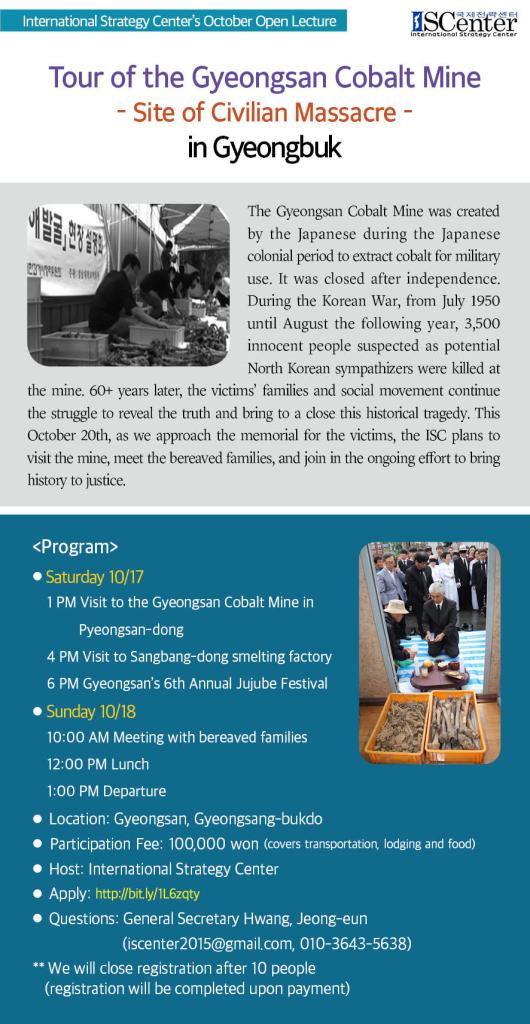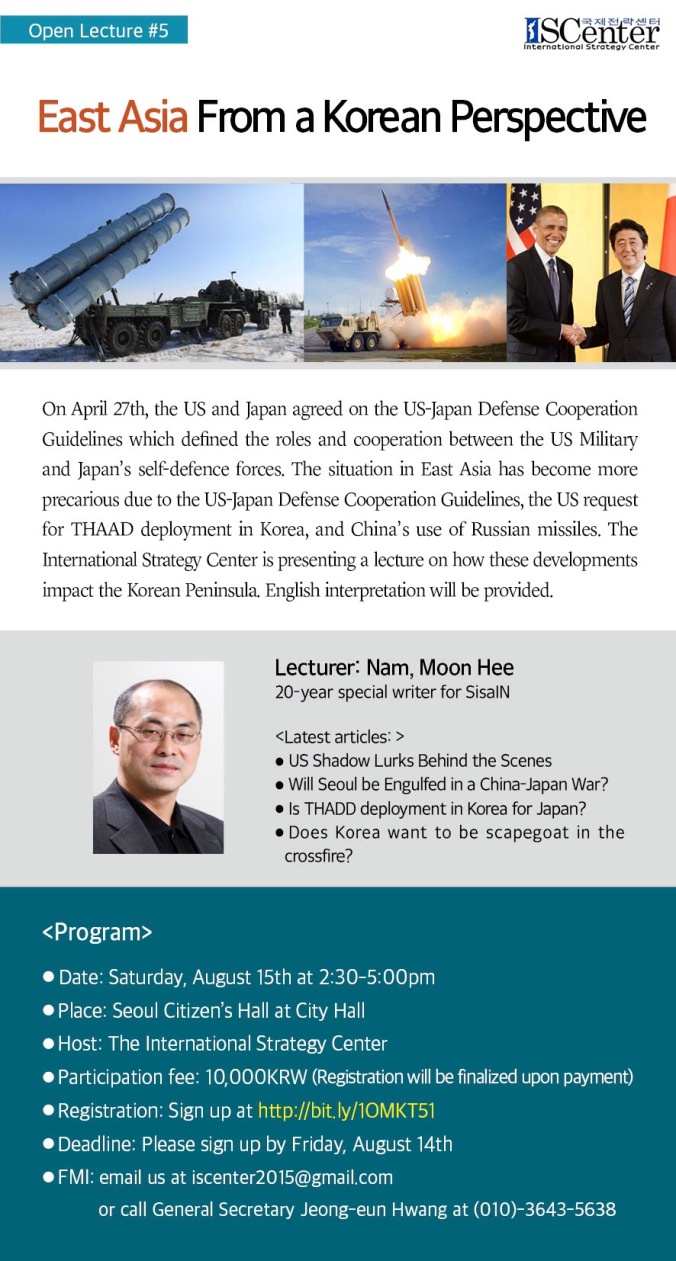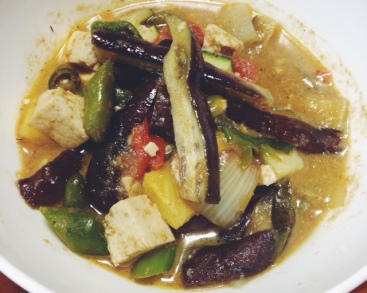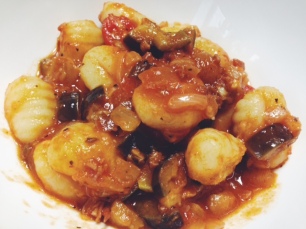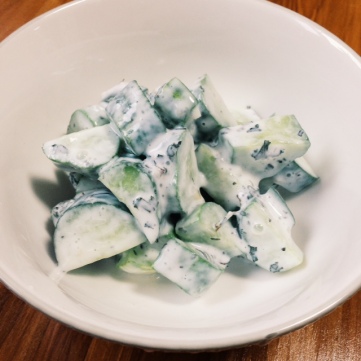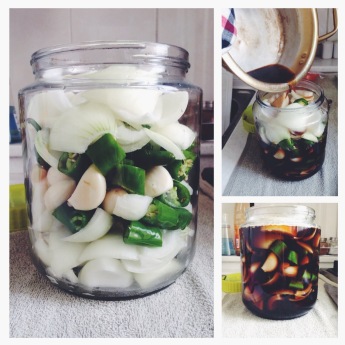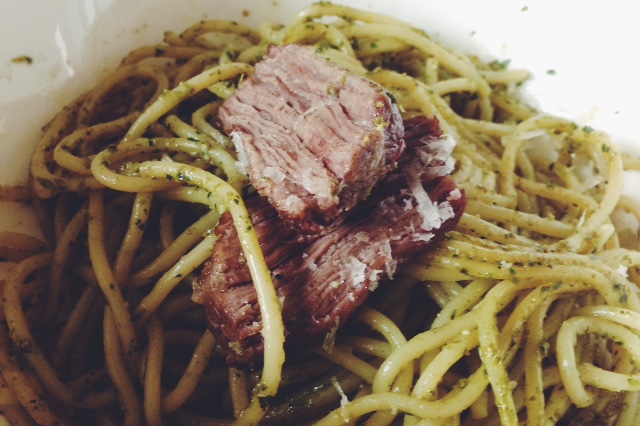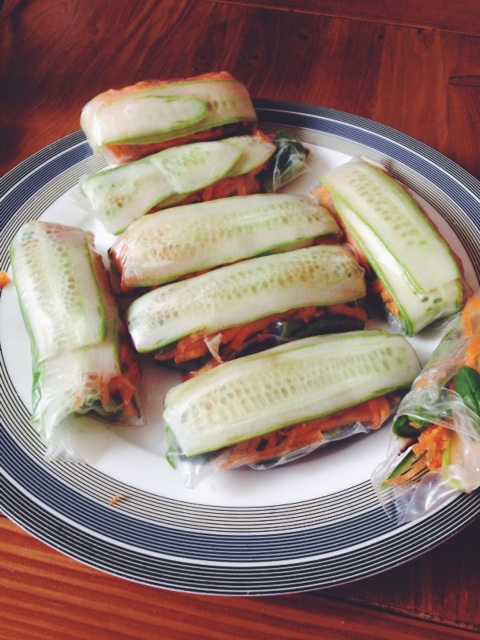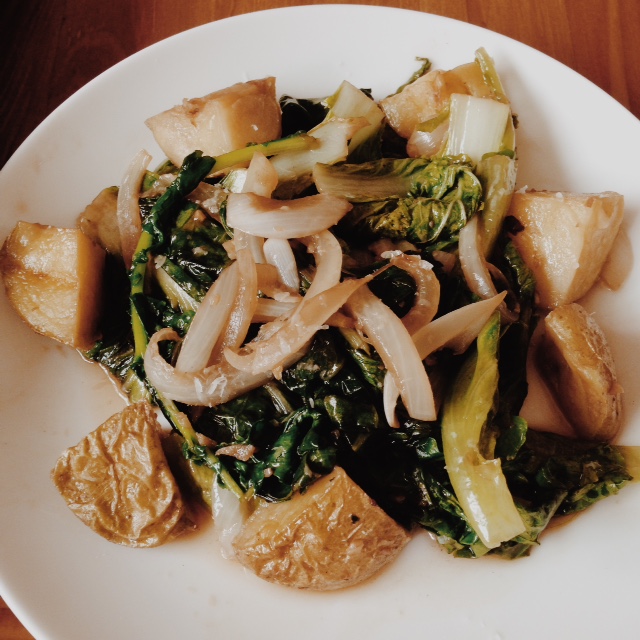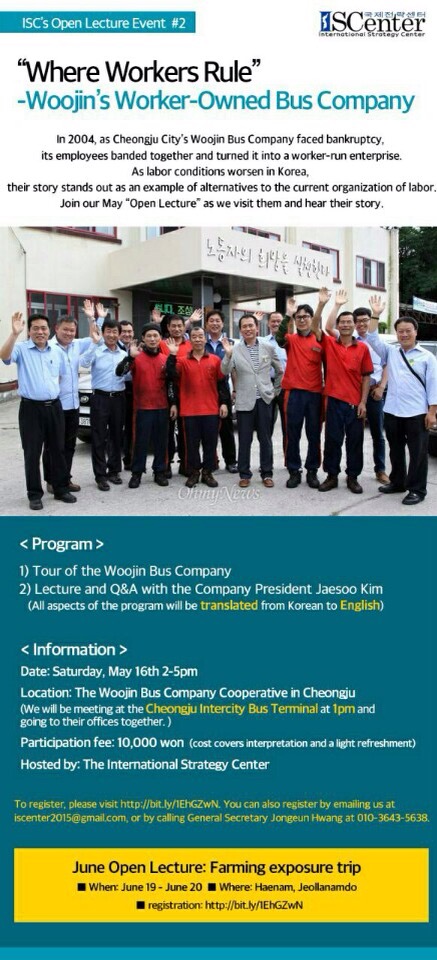Join the ISC as they visit the mine and speak to bereaved families at the site where more than 3,500 innocent people suspected as North Korean sympathizers were killed. Join the mission to bring history to justice.
Farming exposure trip in Sangju
Join the ISC in Sangju, Gyeongsang province, for a weekend of farming and discussion about Korea’s agriculture. Link to register: http://bit.ly/1TDUp0D 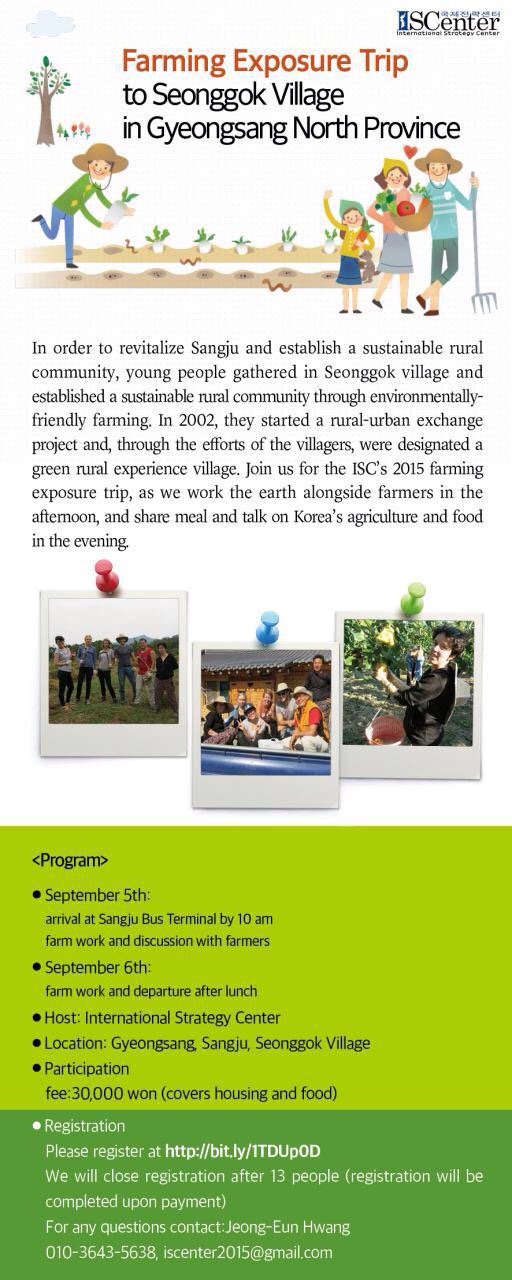
East Asia From a Korean Perspective
Community Supported Agriculture Part 2: More Fun with Fresh Veggies
By Taryn Assaf
Summer can be a difficult time for farmers. Weather can be unpredictable, with high temperatures, too much or too little rainfall; crop eating pests are at their peak. That hasn’t stopped the gorgeous leafy greens and fragrant herbs from growing on Gachi farms. Most people would be weary of buying greens with little holes in them, bruised fruits, or yellowing herbs. We prefer perfection: our greens rich in colour, glistening in the supermarket spotlights; our fruits shining and vibrant; and our veggies without a spot of dirt. You’d be hard pressed to find any evidence that most produce ever existed in an ecosystem. How much food goes to waste simply because its appearance is deemed less than perfect?
The items in my Gachi box are not perfect- and that’s what I love about them. I can feel the carrots being pulled out of the earth as I wash the dirt off them; I can see the rows of leafy greens swaying in the wind as I examine their little holes; I can feel the pride in the harvest of herbs when I receive such plush portions. My relationship to food is changing. I used to be a huge food waster. I was guilty of being afraid of the less than perfect produce. But, I grew wiser, and learned that even a yellowing piece of lettuce can be eaten in a salad and not take away from the freshness or taste. I learned that a bruised apple or orange doesn’t foreshadow the taste of the flesh and that I, like so many others, had little idea what food actually looks like.
I’ve just received my fourth box, but this post will detail some of the items I made with the vegetables from my third box. To reiterate some key points about this package:
- The produce is not enough on its own, but is a great foundation for the weeks’ meals
- You will need to supplement with other items to create well-balanced meals
- The element of surprise really incites creativity in the kitchen
- The food is seasonal, meaning you’ll likely encounter produce you’ve never dealt with before, which also means you may have to do a little research before meal time (hence this post!)
OK! On to the food (again, pics are NOT FOODIE STATUS. I’m about making good tasting food that looks like a normal person cooked it, but moreso I can’t bear to waste time making my food look good for a photo when I could be eating it). In my third box, I received:
Eggplant, onions (not pictured), green peppers, a variety of greens (perilla leaf, arugula, salad greens), buchu (garlic chive), blueberries, six eggs, two cucumbers and a bunch of arugula.
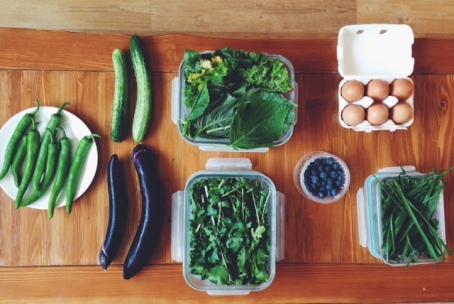
I have a bunch of portioned hanu (Korean beef) in my freezer that has been waiting to become a good topper. I used to love the combination of steak and arugula when I was living in Canada, so the first thing I made was a steak and arugula salad.
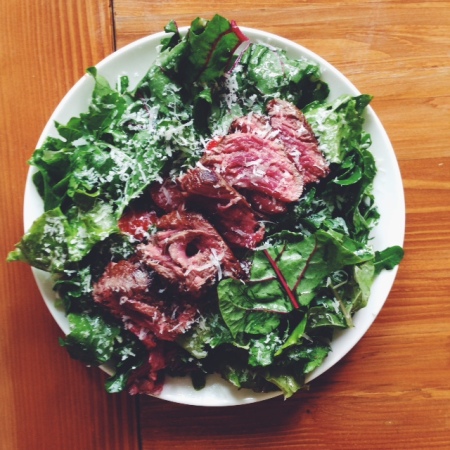 I plumped up the salad with some of the other leafy greens I was given and made a light, lemony vinaigrette. I added some cherry tomatoes from a previous box for good measure, and topped it with a juicy, seared steak.
I plumped up the salad with some of the other leafy greens I was given and made a light, lemony vinaigrette. I added some cherry tomatoes from a previous box for good measure, and topped it with a juicy, seared steak.
Arugula is an amazing green. It’s peppery and fragrant and has a strong flavour. It’s amazing on top of pizzas (proscuitto, parm, mozzarella and arugula is my favorite), in or around anything with steak (steak sandwiches/salads), as the star of the show in an Italian style niciose salad (with lemon, salt, and olive oil dressing and topped with tuna), or even just tossed in lemon juice and placed on top of a piece of fried pork cutlet.
I was so excited about the eggplant. I love to use eggplant in almost anything because it is so versatile; I usually use it in place of animal proteins because of its thick, meaty texture- that means stews, sauces, sandwiches and other meals I would usually prepare with meat get eggplant instead. So I went ahead and prepared a Thai green curry with eggplant (and literally every other vegetable I could use up) and an eggplant parm inspired gnocchi (the gnocchi I got off iHerb.com). Both lasted me a few meals each. I contemplated making baba ganoush, but opted instead for a couple meals with more vitality.
Cucumber is so common that I doubted whether or not I should include it in this post. However, I got really excited about making one of my favorite summer salads: salatat laban wa kh’yar (in Arabic), or, cucumber yogurt salad. It was really difficult for me to find the right yogurt for this recipe (if anyone knows where to order quality, preferably home made greek yogurt, hit me up!) so the yogurt I used was not as thick as this salad usually calls for. There are five ingredients here: cucumber, plain yogurt, dried mint (you can use fresh) garlic and salt. All to taste. Since the yogurt was runny, I only just coated the cucumber, but normally the bowl would be full.
My absolute favorite Korean side dish are pickled vegetables. When I saw onion and green pepper in the box, that’s immediately what came to mind. Together with some garlic that I received the week before, I made my very own. I combined everything in one container, boiled the pickling brine and poured it over top. I let it sit for a few days in the fridge before tasting, so all the brine could really soak in. Since I like my pickled veggies a little sweeter and more sour than what I’ve tasted in the restaurants, I added a little more vinegar and sugar than the recipe called for: 2 cups water, one cup soy sauce, and somewhere between a quarter and a half cup each of vinegar and sugar.
Finally, I used all the perilla leaves I received to make perilla leaf pesto. I’ve been eating pesto or some version of it for 2 months now thanks to Gachi, and I’m not complaining (is there such a thing as too much pesto? No. There isn’t). It’s the exact same recipe as basil pesto, except sub perilla leaves for basil. It tastes very similar, and the perilla leaf flavour, usually overpowering, comes out subtly and smoothly. I tried it a variety of different ways: hot with whole wheat linguine, for a more western feel, and cold with buckwheat noodles, topped with cucumber and eaten with a side of pickled radish, for a more summery Korean noodle feel. Both were great. I didn’t take any pictures, because it looks exactly like basil pesto, (which isn’t very interesting) and everyone knows what that looks like.
What came of the blueberries and buchu? I mixed them into random meals at random times.
So I guess I’m still very much enamored with my community supported agriculture. The box I received this week is even more exciting, challenging and inspiring than what was featured in this post, and I look forward to continuing my culinary endeavors and sharing them. Have you subscribed yet?
ISC’s Open Lecture Series July Event: “War, Peace, Reunification”
We can easily forget as foreigners living in Korea that we are living in a forcibly divided country still at war. Join the ISC in a reunification tour to explore regions of significance to the inter-Korean conflict. You can sign up at http://bit.ly/1eTvmEL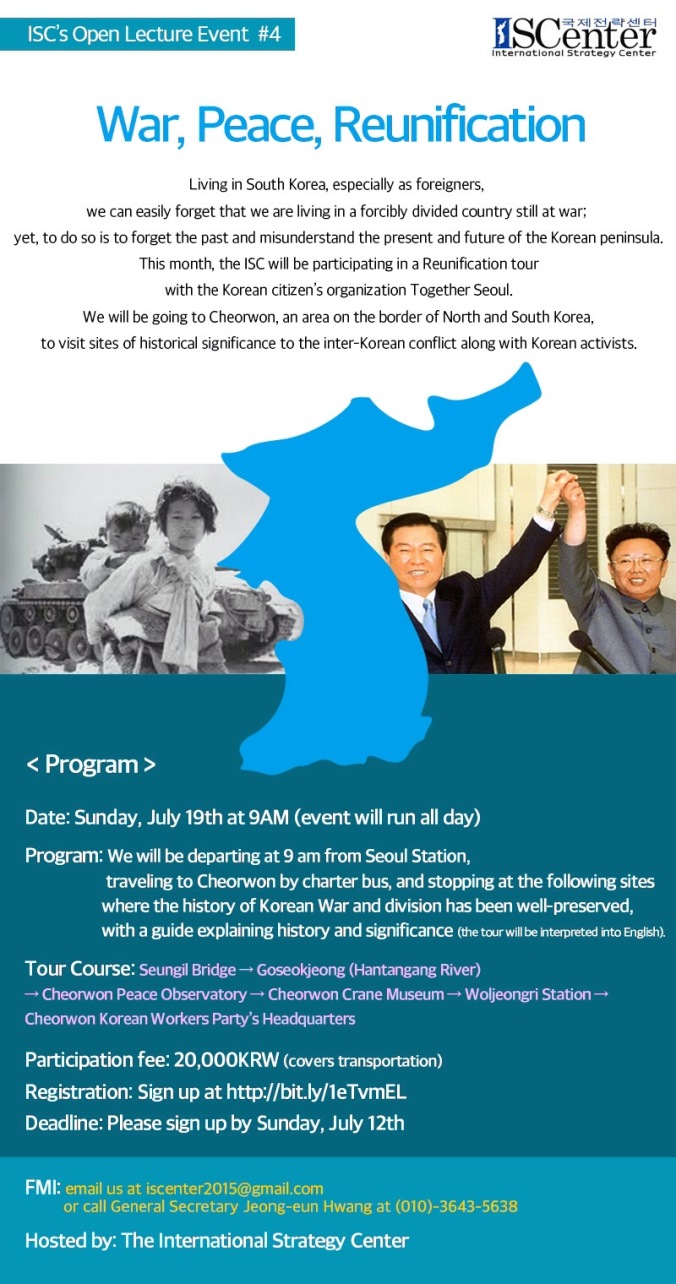
Community supported agriculture: is it worth it?
By Taryn Assaf
If you’ve been thinking about purchasing a share in a CSA, then you likely already know what they are and how they function. If you don’t (from wikipedia: far more eloquent than me):
“A CSA is an alternative, locally based economic model of agriculture and food distribution. A CSA also refers to a particular network or association of individuals who have pledged to support one or more local farms, with growers and consumers sharing the risks and benefits of food production. CSA members or subscribers pay at the onset of the growing season for a share of the anticipated harvest; once harvesting begins, they periodically receive shares of produce.”
“CSAs generally focus on the production of high quality foods for a local community, often using organic or biodynamic farming methods, and a shared risk membership–marketing structure. This kind of farming operates with a much greater degree of involvement of consumers and other stakeholders than usual — resulting in a stronger consumer-producer relationship. The core design includes developing a cohesive consumer group that is willing to fund a whole season’s budget in order to get quality foods.”
CSA theory was developed around three main goals:
“· New forms of property ownership: the idea that land should be held in common by a community through a legal trust, which leases the land to farmers
- New forms of cooperation: the idea that a network of human relationships should replace the traditional system of employers and employees
- New forms of economy: that the economy should not be based on increasing profit, but should be based on the actual needs of the people and land involved in an enterprise”
Is it worth it to buy your produce from a CSA? If you believe in this economic model of agriculture, then you may very well think so. I had been wondering for some time, and finally decided to buy a share in Gachi (formerly WWOOF) CSA. I chose the basic couple’s basket, which delivers a weekly share of eggs, one type of fruit and a variety of vegetables to your door. You can expect different produce every week, and the produce changes seasonally.
I asked the folks at Gachi if they could send me one box every two weeks, as opposed to one a week, and they happily obliged. I’ll be receiving a box bi-weekly for the next three months, and I’d like to share my thoughts, recipes and reasons for purchasing with you so that you can decide for yourself whether you’d like to support community agriculture.
Spoiler: It’s totally worth it.
To begin, Gachi is not the only CSA offering delivery in Korea, although it is the only strictly English one doing so. You can read about a couple other options in my previous post: Korean Peasants Sow the Seeds of Nation’s Food Sovereignty
Why did I choose Gachi? Above all, because they offered the easiest English option available. With my limited Korean skills, it was much easier for me to access than the other options out there. However, it is relatively limited in terms of items to choose from: while the selection is fairly good, (they offer add-ons of meat, fruit, juice, snacks and bread) they still lack options for seasonings, sauces, and processed foods (they do offer some, just not as many as other groups). However, if you know where to go for quality sides and seasonings, then Gachi is still, in my opinion, the best option for English speakers.
On to the food.
Note: If you don’t cook at home often (like, every day) this is probably way, way too much food for one person per week. Hence the two-week option.
In my first box, I received: 6 eggs, cherry tomatoes, arugula (rocket), 2 cucumbers, 1 zucchini, 2 heads of iceberg lettuce, about 2 cups of basil, a variety of ssam (lettuce and cabbage leaves), green gochu peppers and bok choy. There was green everywhere and I loved it. (apologies, my pictures are NOT of professional foodie status; but trust the meals tasted yum)
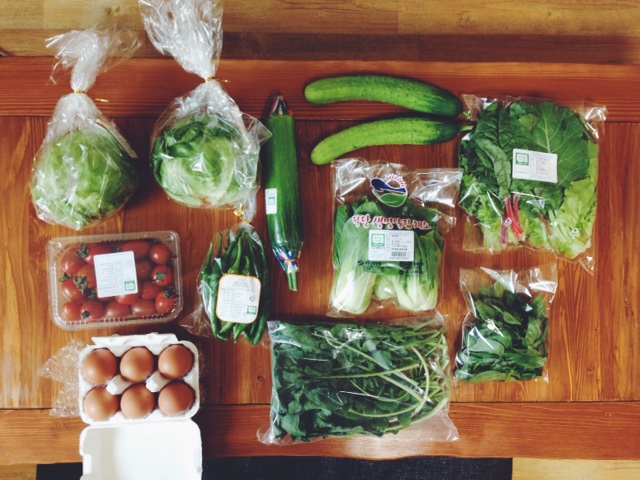
No, I didn’t just eat salad every day, though I definitely could have. Over the two weeks, I managed to use the greens fairly diversely, along with other ingredients I already had to make my meals more balanced. I’m not a vegetarian, but I absolutely whipped up some vegan/vegetarian delights, although some of what I’m going to share with you contains animal protein.
The first thing I made was a large pot of dwenjang soup with the bok choy and green gochu. I added mushrooms that I bought from the market. No pics, but it was enough to feed 6 guests I had for lunch. I could have easily split it up for smaller portions of any soup or stir-fry.
I used some zucchini to make zoodles (zucchini noodles) and whipped up a salmon dish. The zoodles were mixed with carrots and stewed tomatoes, both of which I had lying around. I seared the salmon in lemon butter:
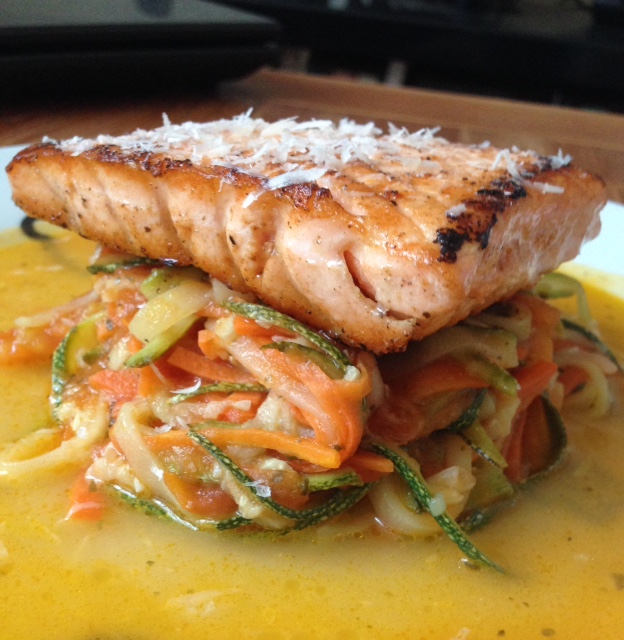 I used the rest of the zucchini to make zucchini chips.
I used the rest of the zucchini to make zucchini chips.
First thing I thought of when I saw the basil: pesto (recipe here. note: you can sub pine nuts with walnuts and pecorino cheese with parm or romano cheese). 2 cups of basil made a load of pesto: I ate pesto pasta for 3 meals this week, and froze the rest. In my first pesto pasta, I sautéed the cherry tomatoes; in my second, I mixed some greens in, and in the final, I seared some Hanu as a nice topper:
I used the remainder of the basil, some ssam leaves, green gochu and some cucumber as an inspiration for vegan rice paper rolls, accompanied by some peanut sauce. I added carrot, mushrooms, and mint that I had in my fridge.
I used my now wilting greens to make a warm salad. First, I sautéed some onion and garlic in olive oil and balsamic vinegar. Then, I added the greens and let them wilt. I tossed some roasted potatoes in for good measure as well. (Tip for your greens: wash them immediately and then transfer them into an airtight container. They’ll keep for longer in the fridge this way)
The eggs I ate nearly immediately: 6 eggs was not enough. I did make a lovely kyeran jjim (egg stew), though.
All in all, I feel great about supporting Gachi farmers. I’m (partially) engaging in a model of agriculture I believe in, and the food is damn good. The box is not meant as a total substitute for your diet. You need to supplement in order to create well balanced meals, although it is a wonderful foundation that inspired me to be more creative with my cooking. I can’t wait to see what comes next week! I hope this post has made the decision easier for some, and that it has introduced others to a more responsible food system. But to everyone, no matter what you choose, I must say, bon-appetit!
ISC Farming Exposure Trip: Join us in Haenam
The South Jeolla Province’s Haenam region has become one of the most popular areas in Korea for the growing number of people choosing to leave the cities and returning to the country’s rural areas to farm. Haenam’s Misae village is a community of young farmers living and working together to build a new way of life. Join the ISC’s Monthly Open Lecture Series as we take part in the village’s farming, learn about why people are returning to the land, and speak with Misae’s villagers about their vision for farming and a more sustainable future. To register, please visit http://bit.ly/1KZAqRt
ISC Open Lecture #2: “Where Workers Rule”
Call to Action: The Truth Must Not Sink With Sewol
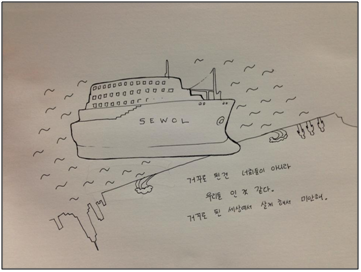 “It is not you that is wrong side up; it is us. I am sorry for having made you live in this wrong side up world.”
“It is not you that is wrong side up; it is us. I am sorry for having made you live in this wrong side up world.”
At 9 AM on April 16, 2014, after making a sharp turn, the Sewol ferry, its decks overladen with cargo, began to capsize off the southwest coast of South Korea. Hasty news reports of a full rescue raised family’s hopes only to dash them against the reality that only 172 had been evacuated and rescued, and 304 – mostly high school students – remained trapped inside. As the government stalled and fumbled through its emergency response during the “golden moments” of rescue, and as minutes turned to hours, and days into months, hope of rescue faded and anger mounted exacerbated by reckless inaccurate media reports and the government’s attempts to cover-up its ineptitude and sluggish response. A perfect storm of corporate greed, lax regulation, corruption, and government incompetence turned a simple accident into Korea’s worst maritime disaster in 40 years and questioned the legitimacy of a government focused on economic growth but negligent of its people’s well-being.
Now, nearly a year later, 295 bodies have been recovered, but 9 remain missing. Countless demonstrations, six million signatures, an eight month occupation of Gwanghwamun Square, and hunger strikes by the victims’ families have been carried out demanding the full truth behind the tragedy and punishment of those responsible. The government remains unresponsive paralyzed by special interests and fearful of the full implications of the truth; with bodies still missing and the truth covered up, victims’ families are denied the closure necessary to move on.
To uncover the truth and prevent such senseless deaths in the future, the victims’ families have been demanding the creation of a committee with full investigative and prosecutorial authority. The government’s response has been a timid anemic committee that has still not launched a full investigation due to departmental budget disagreements. Furthermore, while the families of those still missing are demanding the recovery of the Sewol to recover the missing bodies and uncover the truth, the government is balking ostensibly due to the costs of such mission.
Punishment for those responsible has been slow. The chief executive officer and five other employees of Cheonghaejin Marine, which owned the Sewol, are being prosecuted for negligence in the conduct of business, professional negligence resulting in death, and violating the Ships Safety Act after re-operating a 20 year old retired ship, illegally restructuring it, and overloading its top decks with cargo for greater profits. However, the current legal system makes difficult prosecution of these companies or its executives.
As the one year mark approaches on April 16th, some say, “Enough, stop fighting and just commemorate the one-year memorial quietly.” Yet, how can we ensure such tragedy does not re-occur? How can we give closure to victims’ families when the truth is covered up, the culprits are not held responsible, and nine bodies remain missing?
We must struggle against time, against the government’s efforts to cover up the truth, against a government-dominated media, and against our own apathy, so that we do not forget, and so that we can create a society that values people’s well-being and safety over profits and where such tragedy cannot re-occur.
The International Strategy Center stands with the victims’ families and demands:
- A full investigation into the truth behind the Sewol ferry disaster
- Punishment of those responsible for the disaster
- Recovery of the Sewol ferry and the nine missing bodies
Please support our call and consider:
- Signing our petition demanding that the government carry out the victims’ families’ demands.
- Participating in our photo campaign by posting a photo on Facebook or Twitter holding a sign with where you are (city and country) along with the hashtag #thetruthmustnotsinkwithsewol, and sending us a copy of your picture to iscenter2015@gmail.com
- Organizing others to join the campaign.
- If you are living in Korea, attend our Open Lecture event on April 11th with the families of the Sewol victims [further information and registration at http://bit.ly/1Ovc3yv.]
We will be displaying the photos in our April issue of the Monthly World Current Report and handing them along with the petition to the family members as a gesture of solidarity. Through this campaign, we hope to raise international awareness to the reality that the Sewol tragedy remains unresolved, and to place international pressure on the Korean government to bring relief to the families who have suffered long enough.
Thank you for your support!
Korean Farmers: The Value of Local Knowledge
By Erica Sweett
In October the ISC met with Korean farmers. We were welcomed into their homes, fed fresh food and given tours of rural and urban farmlands. They shared their stories and shared the struggles Korean farmers are facing. We experienced a side of Korea often shadowed by economic progress raising questions about what and who is valued within societies. Who is supported? Whose knowledge is valid?
Today, Korea is known globally for its multinational tech companies, like Samsung and LG, but not long ago it was a country that survived almost solely on farming. In 1970, fifty percent of the populations were farmers. It’s safe to assume that farming was a significant part of Korean identity and culture during that time.
The Korean War, US food aid, along with neoliberal policies and bilateral agreements led not only to a decline in agriculture but also to one in rural communities and indigenous traditions and cultures. In the 1970s, in response to US economic pressure, the Korean government implemented Green Revolution agricultural practices. The Green Revolution modernized farming in Korea and educated farmers on technological advances in farming. It also increased the use of fertilizers and introduced new seeds.
The Green Revolution proved to be unsustainable. This “revolution” stripped farmers of their right to land, seeds and farming methods. Farmers traded their traditions and small family farms to buy fertilizers and heavy machinery. The increased cost of these new technologies forced many farmers to switch from growing a diversity of crops for domestic consumption to growing cash crops. As a result Korea has become more reliant on global food corporations. Today over 60 percent of their food comes from imports. (Jeong Kim, 2013, p.1)
Near the end of the 1980s, the government was dedicated to manufacturing and neoliberal free trade policies. Many farming communities were further destroyed as the government focused its energy and resources on increasing production and maximizing profit. The Korean government discredited and devalued its farming communities and left them vulnerable to global markets where they stood no chance of competing. By 2010, farmers were only 7 percent of the population.
Life as a farmer is unpredictable. Weather, bugs, disease and seeds are some factors that affect harvests. Farmers have to be resourceful and resilient. Yet, the politico- economic forces they confront are more powerful than any natural disaster or pest. Korean farmers are working hard to preserve their local knowledge and wielding it against neoliberal driven policies.
Korean farmers are resisting the decline in local farming. The Korean Peasants’ League (KPL) and The Korean Women’s Peasant Association (KWPA) are fighting against neoliberal free trade agreements in solidarity with farmers around the world. They are initiating back to the land movements and are sharing their indigenous knowledge and traditions; they are reviving rural communities and creating a new collective conscience that emphasizes local self-sufficient agriculture within Korea; they are giving power and control back to the people. The results are tastier food and happier, healthier communities.
KWPA is helping empower women farmers; they are protecting indigenous seeds and building relationships with local consumers. Older women farmers are sharing their knowledge with the younger farming generation. The older generation is not educated in the way modern society appreciates. “Most of them are illiterate, but experts of indigenous agriculture” (Jeong Kim, 2013, p. 2). Their deep connection to the land is vital to the future of local, traditional farming methods. The KWPA is a progressive movement that recognizes the importance of the past. “The young generation makes it possible to reconsider the role and value of women peasants, who had been undervalued and excluded from the capitalized market economy system in the process of modernization” (Jeong Kim, 2013, p.3). The Korean government deemed the older generation of women farmers as obsolete and their knowledge as meaningless. The KWPA is building a space where the value of these women can be realized and their knowledge can be used to improve the future of local communities.
The KWPA’s Sister’s Garden Plot slogan is: “An honest producer and a caring consumer: Together we can solve the problem”. They are simplifying the process food goes through before reaching consumers’ tables. Their pamphlet states that, “As consumers increase, rather than increase the scale of production, it is better to create a larger community in which producers and consumers meet.” They focus on local, seasonal farming – which is cheaper – and better for the environment. The food they grow goes directly back to the community. They have the freedom to grow food more sustainably because they’re controlled by their local market not by the restraints of the global market.
Capitalism can foster innovation and can efficiently boost economies. But it’s important to be aware of its limitations. Capitalism is independent of culture and community and displaces and devalues local knowledge. Multinational companies are protected by conflicting laws and trade agreements that limit access to local food and discourage localized, sustainable farming. Under capitalism everything is disposable and replaceable. Economic competition disrupts the natural cycle of growing, harvesting and producing food. Korea started growing cash crops because it’s economically more efficient. They became more reliant on food exports not because it’s practical – but because of trade laws and barriers that dictate what governments deem important.
We already have the necessary tools to create sustainable food sources. We have the farmers and their knowledge; what we need is a structural shift within society that supports and encourages local farmers. The needs of the global market differ greatly from those of the local markets. Cooperative communities need to be valued over the profitability of capitalism. We need to stop allowing multinational corporations and the governments who support them decide what and who should be valued within societies.
The battle facing farmers in Korea isn’t just a localized issue- it’s a global one. It is a collective struggle that affects all of us. Korean farmers have many roles. They are teachers, activists and protectors of their land and culture. Farmers, more than anyone, are aware of the grave dangers facing our planet. Farmers are a vital part of societies and their voices need to not just be heard, but listened to and valued.
Bibliography:
Hyo Jeong Kim. (2013, September 14-15) Women’s Indigenous Knowledge and Food Sovereignty: Experiences from KWPA’s Movement in South Korea. Paper presented at Food Sovereignty: A Critical Dialogue, International Conference, Yale University (1-19).
